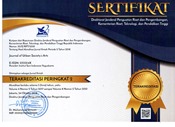The Journey of Finding Paths in Javanese Court Dance by Sensory and Somatic Experiences of Taiwanese
Abstract
Is it possible to discover the spirit of another culture just by feeling without knowing? What happened when Taiwanese met the Javanese court dances with body and senses only? Can we compare Srimpi (one of the court dance forms of Java) and Tai Chi Chuan of China? How to learn and feel the dance culture? In the Javanese court dance workshop, my classmates and I were in our own “webs of senses” instead of “webs of meanings” to embody a little bit of Javanese court in Taiwan. To listen to gamelan music, to touch the sampur (a long strip of cloth used while dancing) and floor, to shape the body in the frame, to feel other dancers’ movements; all that confused us and made us get lost in the contexts of Java for a long time. Finding paths to learn the dances is a personal journey for one’s own and via which one may understand more about different cultures and more about oneself as well. I will share the experiences of some learners, including myself, to discuss the meanings of what we suffered and what we rebuilt.
Perjalanan Menemukan Tuntunan dalam Menarikan Tarian Keraton Jawa melalui Pengalaman Sensori dan Somatik Orang Taiwan. Mungkinkah menemukan semangat budaya lain hanya dengan merasakan tanpa mengetahui? Apa yang terjadi ketika orang Taiwan bertemu dengan tarian keraton Jawa hanya dengan tubuh dan indera mereka? Bisakah kita membandingkan Srimpi (salah satu tarian keraton Jawa) dengan Tai Chi Chuan dari Cina? Bagaimana cara mempelajari dan merasakan budaya dari sebuah tarian? Dalam lokakarya tari keraton Jawa, saya dan teman-teman sekelas berada dalam “perangkap indera” kami sendiri, bukannya “perangkap makna” untuk mewujudkan sedikit keraton Jawa di Taiwan. Mendengarkan musik gamelan, menyentuh sampur dan lantai, membentuk tubuh agar sesuai bingkai, merasakan gerakan penari lain; semua membingungkan kami dan membuat kami tersesat dalam konteks Jawa untuk waktu yang lama. Menemukan tuntunan untuk mempelajari tarian adalah perjalanan yang bersifat pribadi, dan melalui perjalanan tersebut seseorang dapat memahami lebih banyak tentang budaya yang berbeda maupun tentang diri sendiri. Saya akan membagikan pengalaman beberapa pelajar Taiwan, termasuk saya sendiri, untuk menjelaskan kesulitan yang telah kami lalui dan apa yang berhasil kami bangun kembali.
Keywords
Full Text:
PDFReferences
Geertz, C. (1973). The Interpretation of Cultures. New York: Basic Books.
Hughes-Freeland, F. (2008). “Becoming a Puppet”: Javanese Dance as Spiritual Art. The Journal of Religion and Theatre, 7(1), 35–54.
Mauss, M. (1973). Techniques of the body. Economy and Society 2, 70–88.
Suharto, B. (1992). Cosmology and Aesthetics of the Javanese Dance. SPAFA Journal, 2(3), 25–30.
Tsai, B. M. (2011). “Hold Du Meridian Still” and “Align the Body along the Du Meridian”: A Study on Body Experience and Body Technique as a Newly Discovered Method for Bridging the Studies of Laozi and Zhuangzi. Bulletin of the Department of Chinese Literature, 34, 1–54.
Yu, S. (2016). Bodily Sense: a theoretical turn in the investigation of bodily sense. In Yu Sung-der ed. Reorientation of bodily sense. Taipei: National Taiwan University Press.
(余舜德 2016 身體感 : 一個理論取向的探索身體感的轉向。身體感的轉向。余舜德
主編 , 國立台灣大學 , 台北。)
DOI: https://doi.org/10.24821/jousa.v8i2.6151
Refbacks
- There are currently no refbacks.

This work is licensed under a Creative Commons Attribution 4.0 International License. ISSN 2355-2131 (print) | ISSN 2355-214X (online).






